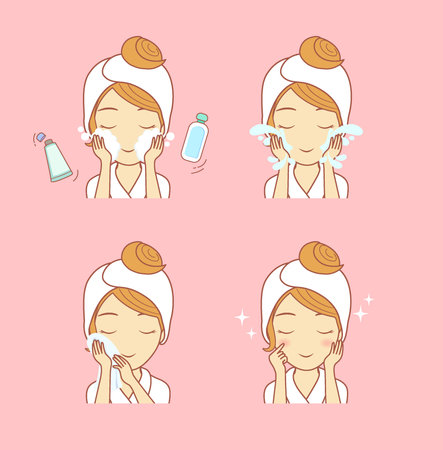Introduction: Debunking British Winter Skincare Myths
As winter settles over the UK with its biting winds and persistent drizzle, many Britons reach for skincare solutions that promise to combat the season’s notorious effects. However, a surprising number of misconceptions about winter skincare continue to circulate throughout the country—often passed down through generations or spread through social media. From believing that sunscreen is only necessary in summer, to assuming oily skin doesn’t need moisturiser during colder months, these myths can lead to less-than-optimal skin health. This article will take a closer look at some of the most common winter skincare myths in Britain, analysing why they persist and what you should actually do to keep your skin healthy when the mercury drops. Understanding these widespread beliefs—and the facts behind them—can help everyone in the UK avoid costly mistakes and ensure their skincare routine is truly fit for British winters.
Myth: You Don’t Need Sunscreen in Winter
One of the most persistent misconceptions about winter skincare in Britain is the belief that sunscreen becomes redundant once the temperature drops. While it’s true that British winters are famously grey and drizzly, UV rays don’t take a holiday just because the sun is hiding behind clouds. In fact, up to 80% of UV rays can penetrate cloud cover, meaning your skin remains vulnerable to damage even on those quintessentially overcast UK days.
Why UV Protection Still Matters
Though we might associate sunburn with summer afternoons spent lounging in Brighton or Cornwall, the reality is that UVA rays – responsible for premature ageing and long-term skin damage – maintain a consistent intensity throughout the year. This means your daily commute through Manchester drizzle or a weekend stroll through Edinburgh’s wintry parks still exposes your skin to harmful effects.
Common Winter Sunscreen Myths vs. Facts
| Myth | Fact |
|---|---|
| You don’t need SPF on cloudy days | Up to 80% of UV rays penetrate clouds |
| Sunscreen is only necessary during summer | UVA exposure is consistent year-round |
| Sunscreen isn’t needed indoors | UV rays can pass through windows, especially UVA |
| Darker skin tones don’t require SPF | All skin tones are susceptible to UV damage and ageing |
Choosing the Right Sunscreen for British Winters
For effective protection, opt for a broad-spectrum sunscreen with at least SPF 30. Lightweight, non-greasy formulas are ideal for layering under moisturiser or makeup, making them practical for daily use even when you’re bundled up in scarves and coats. Look for products that offer added hydration, as central heating and biting winds can exacerbate dryness during the colder months.
The bottom line? Don’t let Britain’s winter gloom lull you into a false sense of security. Consistent sunscreen use is a cornerstone of smart skincare—no matter how chilly or cloudy it gets outside.

3. Myth: Hot Showers Prevent Cold-Weather Dryness
Britons are renowned for their love of a piping hot bath or shower, especially when the chill sets in and daylight hours dwindle. There’s something quintessentially British about escaping the damp cold with a steaming soak, but does this habit actually help your winter skin? Contrary to popular belief, indulging in scalding showers can do more harm than good when it comes to maintaining skin health during the colder months.
Why Hot Water Feels Comforting—but Isnt Helpful
It’s easy to see why many people reach for the hot tap: the sensation is comforting and seems to counteract the biting wind outside. However, dermatological evidence suggests that frequent exposure to very hot water strips away natural oils from your skin’s surface, leaving it more vulnerable to dryness, irritation, and even conditions like eczema or dermatitis.
The Science Behind Skin Barrier Damage
Your skin’s barrier function relies on a delicate balance of lipids and moisture. Hot water disrupts this equilibrium by dissolving these essential oils much faster than lukewarm water. This effect is magnified in winter when humidity drops and indoor heating saps even more moisture from the air—and your skin.
Comparing Shower Habits: Hot vs. Lukewarm
| Shower Temperature | Immediate Sensation | Long-term Skin Effect |
|---|---|---|
| Hot (above 40°C) | Comforting warmth; relieves cold | Strips oils; increases dryness and sensitivity |
| Lukewarm (30–37°C) | Mild warmth; less steamy | Keeps moisture intact; better for sensitive or dry skin |
What Should You Do Instead?
If you want to avoid exacerbating winter dryness, consider opting for shorter showers at a moderate temperature and patting your skin dry instead of rubbing vigorously. Immediately follow up with a fragrance-free moisturiser to lock in hydration—an easy swap that makes a noticeable difference over time.
The British Way Forward
While it might be hard to say goodbye to those beloved hot baths during dark British winters, understanding the myth behind them helps you make more informed choices for your skincare routine. Remember: comfort doesn’t have to come at the expense of healthy skin.
4. Myth: Oily Skin Doesn’t Need Moisturising
One of the most persistent winter skincare myths in Britain is the belief that those with oily skin can skip moisturiser, especially during the colder months. The logic seems straightforward: if your skin already feels greasy, why add more hydration? However, this approach can actually backfire, particularly when facing Britains unique combination of chilly winds and central heating.
Why Skipping Moisturiser Is a Mistake
When temperatures drop and radiators are switched on across the UK, the air becomes significantly drier both outside and indoors. Cold air strips away moisture from the skin’s surface, while central heating further depletes natural hydration. Even if your skin produces excess oil, these environmental changes can disrupt your skin’s barrier function. Without a proper moisturiser, your skin may overcompensate by producing even more oil, leading to congestion and breakouts.
How Winter Air & Central Heating Affect All Skin Types
| Skin Type | Common Issues in Winter | Impact of Skipping Moisturiser |
|---|---|---|
| Oily | Increased oiliness, clogged pores | Dehydration triggers more oil production; uneven texture |
| Combination | Dry patches, shiny T-zone | Exacerbates dryness and oil imbalance |
| Dry | Tightness, flakiness | Severe dehydration, irritation |
| Sensitive | Redness, itching | Greater reactivity, compromised barrier |
The Right Approach for British Winters
No matter your skin type, using a lightweight, non-comedogenic moisturiser is key during winter in Britain. Gel-based or water-based formulas hydrate without clogging pores. Look for ingredients such as hyaluronic acid or glycerin that attract moisture to the skin while remaining breathable. Embracing this step ensures your complexion remains balanced despite the drying effects of frosty air and relentless radiators—a crucial strategy for healthy winter skin in the UK.
5. Myth: Heavier Creams Are Always Better
The common belief that heavier creams are the ultimate solution for winter dryness is widespread across Britain. However, this isnt a one-size-fits-all approach—especially given the UKs unique climate, which combines cold temperatures with persistent dampness. Thick, occlusive creams may seem comforting, but they can actually create new problems for many people.
Understanding the Role of Heavy Creams
Heavier creams are designed to provide a barrier against moisture loss by sealing in hydration. While this can be beneficial during harsh, dry spells, British winters are rarely completely dry. Instead, the air is often humid, and layering on dense products can sometimes lead to clogged pores, congestion, and even breakouts—particularly if your skin type tends towards combination or oily.
Comparing Skincare Needs by Skin Type in the UK Winter
| Skin Type | Recommended Texture | Potential Issues with Heavy Creams |
|---|---|---|
| Dry/Sensitive | Rich but breathable creams; ceramide-based formulas | Generally beneficial but avoid formulas with comedogenic oils |
| Oily/Combination | Lightweight gel-creams; water-based hydrators | Heavy creams may clog pores and worsen shine |
| Normal | Mid-weight moisturisers with humectants | May feel too greasy or cause minor congestion |
The Importance of Ingredients Over Texture
Rather than simply reaching for the thickest product you can find, pay close attention to ingredients. Look for humectants like glycerin or hyaluronic acid that draw moisture into the skin, paired with non-comedogenic emollients such as squalane or shea butter. In fact, British dermatologists often advise layering lighter hydrating serums underneath a moderate moisturiser to achieve optimal balance without overwhelming the skin.
Key Takeaway for UK Winters:
The British climate demands a tailored approach: while some may benefit from richer creams during cold snaps, most people will fare better with formulas that hydrate without suffocating the skin. Always patch-test new products and adjust your routine based on how your skin responds throughout the season.
6. Common Product Pitfalls and Ingredients to Avoid
As British winters bring biting winds and plummeting temperatures, many turn to the high street in search of skincare solutions. However, the allure of popular products can sometimes mask the presence of harsh ingredients that may exacerbate dryness, irritation, or sensitivity—especially during the colder months. Here’s a detailed review of commonly used British skincare brands and the ingredients you should be wary of when selecting your winter regimen.
Understanding Hidden Irritants in Popular Products
While brands like Simple, Nivea, Boots No7, and Liz Earle are household names across the UK, not all their offerings are ideal for winter skin. Many cleansers, toners, and moisturisers marketed as suitable for all seasons may contain elements that strip natural oils or disrupt your skin barrier.
Key Ingredients to Watch Out For
| Ingredient | Commonly Found In | Why to Avoid in Winter |
|---|---|---|
| Sodium Lauryl Sulphate (SLS) | Cleansers, face washes | Highly stripping; can worsen dryness and irritation |
| Alcohol Denat. | Toners, astringents | Quickly dehydrates skin; increases sensitivity to cold air |
| Synthetic Fragrance/Parfum | Moisturisers, lotions | Can trigger redness and allergies, particularly on chapped skin |
| Methylisothiazolinone (MI) | Creams, wet wipes | A common allergen; may cause dermatitis in sensitive individuals |
| Essential Oils (high concentration) | “Natural” skincare lines | Potentially sensitising in dry air or compromised skin barriers |
| Benzoyl Peroxide/Salicylic Acid (overuse) | Blemish treatments | Effective for spots but extremely drying when overused in winter |
The British High Street: A Mixed Bag for Winter Skincare?
Boots No7 Protect & Perfect creams are widely praised for anti-ageing benefits but some formulas include alcohol denat., which could aggravate already parched skin. Similarly, Simples classic cleanser is gentle but beware of their foaming variants containing SLS. Nivea’s soft cream is rich but often includes fragrance—an unnecessary risk if your skin is cracked or wind-chapped.
What Should You Choose Instead?
Opt for fragrance-free, alcohol-free options with hydrating ingredients such as glycerin, ceramides, and hyaluronic acid. Brands like CeraVe and Eucerin—now easily available at Boots and Superdrug—offer formulas specifically designed for sensitive winter skin. Always read labels closely: what works in summer may not suit you come January’s frost.
7. Conclusion: Updating Your Winter Skincare Routine the British Way
As we wrap up our exploration of winter skincare myths in Britain, it’s clear that separating fact from fiction is crucial for maintaining healthy skin during the colder months. The British winter brings unique challenges—bitter winds, fluctuating indoor heating, and persistent dampness—all of which can wreak havoc on your skin if you’re not careful about your regimen.
Making Evidence-Based Choices
Smart skincare isn’t about following trends or old wives’ tales; it’s about understanding what your skin genuinely needs and adapting to local conditions. Here’s a quick summary of how to make informed decisions:
| Myth | Reality | What to Do Instead |
|---|---|---|
| Heavy creams are always better in winter | Not all skin types need thick creams; too heavy can cause breakouts | Choose moisturisers based on your skin type—consider hydrating serums with humectants for oily/combination skin |
| You don’t need SPF in Britain’s winter | UV rays penetrate clouds; sun protection is still necessary | Apply a broad-spectrum SPF daily, even on gloomy days |
| Hot showers help hydrate dry skin | Prolonged hot water strips natural oils and worsens dryness | Opt for lukewarm water and limit shower time |
Your British Winter Skincare Checklist
- Assess your skin type before switching products
- Look for evidence-based ingredients like ceramides, hyaluronic acid, and gentle cleansers free from SLS (sodium lauryl sulfate)
- Avoid over-exfoliating, especially with physical scrubs—stick to mild chemical exfoliants if needed
- Layer products: lighter serums first, then creams or oils as needed
- Keep your environment in mind—humidifiers can combat central heating dryness indoors
The British Approach: Practicality Meets Science
Bespoke routines work best. Don’t be swayed by marketing hype or outdated advice. Instead, consult dermatologists when unsure and focus on simplicity, consistency, and proven ingredients. With this evidence-led approach, you’ll not only avoid common pitfalls but also enjoy resilient, comfortable skin throughout the UK winter.


